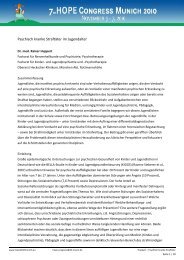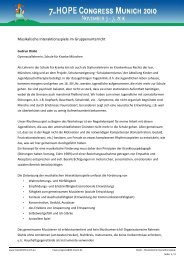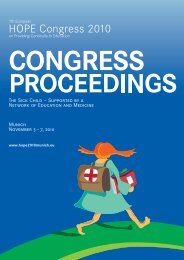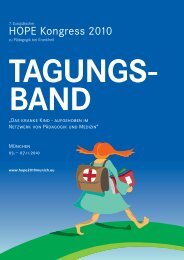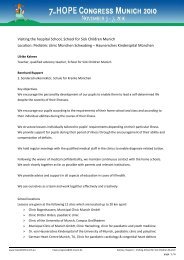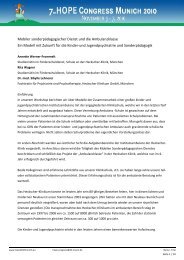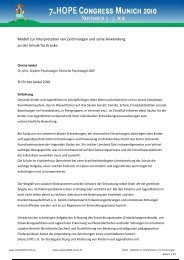HOPE Kongress 2010 - Hope Congress Munich 2010
HOPE Kongress 2010 - Hope Congress Munich 2010
HOPE Kongress 2010 - Hope Congress Munich 2010
Erfolgreiche ePaper selbst erstellen
Machen Sie aus Ihren PDF Publikationen ein blätterbares Flipbook mit unserer einzigartigen Google optimierten e-Paper Software.
80 7th European <strong>HOPE</strong> <strong>Congress</strong> <strong>2010</strong><br />
40+ programs in 20+ health sites statewide) and the inclusion of Liaison<br />
Teachers in many of the inter-disciplinary health teams in these hospitals<br />
and community CAMHS clinics. We now service an average of 4300<br />
students/year (40% primary, 60% secondary) and, as programs have<br />
shown evidence of their inherent value and been maintained, HSS staffing<br />
has increased now to 72 teaching and support staff (many part-time), with<br />
assistance from approximately 40 volunteers.<br />
Four HSS Outcomes and Evidence for Collaboration<br />
At HSS, we value most highly four outcomes in our work - providing a<br />
relevant educational program; collaborating with schools of long-term or<br />
chronically ill students; collaborating within inter-disciplinary teams and<br />
with other agencies to support educational, medical and psychosocial<br />
needs; and facilitating a student’s transition back to school or toward<br />
another study or career path. These goals have been considered and<br />
reinforced repeatedly by evidence gathered on effective collaboration by<br />
education services in health settings and are the basis for development of<br />
our liaison services. The references provided at the close of this transcript<br />
provide examples, but to note a few:<br />
• Closs & Norris (2001) found a positive educational outcome more likely<br />
for a chronically ill student when: partnerships existed, planning was<br />
conducted as early as possible, professional learning was conducted for<br />
enrolled school staff and the student’s enrolled school had a positive<br />
ethos to support the student.<br />
• Farrell & Harris (2003) highlighted five overarching themes for effective<br />
policy and practice as: mainstream ownership (for connection),<br />
collaboration (for consistency), flexibility (for practical solutions),<br />
responsiveness (for timely delivery & good process) and clarity (of roles<br />
& boundaries).<br />
• A Western Australian survey (Gardiner, 2006) followed these findings by<br />
asking teachers what they worried about when it came to students in their<br />
schools with chronic illness and teachers wanted: greater knowledge<br />
and understanding of the health condition and its impact, access to<br />
assistance in addressing the student’s changing health related needs<br />
and support from someone who understands the classroom context.<br />
• Most recently Payne & Valentine (<strong>2010</strong>), both accomplished<br />
paediatricians, acknowledged the importance of education staff in<br />
health teams by stating that “current models of interdisciplinary care<br />
should incorporate education staff as a matter of course.”<br />
Liaison Teacher Roles<br />
III. Workshops und Foren<br />
Liaison Teacher in Mental Health Teams<br />
The Liaison Teacher role is obviously very similar across all specialty<br />
health teams but some differences arise according to the nature of the<br />
conditions supported, so in the time available I will highlight two as<br />
examples. Liaison Teachers were piloted and established in several mental<br />
health settings/CAMHS teams after recommendations from a 2004 review<br />
of the Western Australian Education system and students with psychiatric<br />
disability. Within these specific teams they have been given the acronym<br />
CELT (CAMHS and Education Liaison Teacher).<br />
CELT Role<br />
The following define the role of a CELT:<br />
• Consultancy to CAMHS clinicians on educational matters<br />
• Direct consultation to government & private schools for students who<br />
are “active” clients with CAMHS and have signed parental consent for<br />
CELT support<br />
• Liaise with schools and ‘Student Services’ teams regarding individual<br />
students<br />
• Broker professional learning with health clinicians for schools and<br />
district education offices<br />
• Make educational assessment in collaboration with CAMHS & through<br />
liaison with school & regional services<br />
• Offer generalist mental health advice, including classroom observation<br />
& modelling<br />
• Facilitate a student’s transition planning<br />
• Support schools with funding applications for Severe Mental Disorder<br />
• Help schools understand how CAMHS services work<br />
• Facilitate flexible service delivery by clinicians.<br />
The CELT role has now expanded into CAMHS teams state-wide in<br />
response to the extremely positive feedback received from the health<br />
and education sectors through various evaluations. For example, one<br />
Consultant Psychiatrist commented that ‘it functions as an extremely<br />
useful and beneficial service to help coordinated management in what<br />
is an extremely complicated overlap between Education and Health.’<br />
Most recently Grant Wheatley, Principal Hospital School Services, was<br />
recipient of the <strong>2010</strong> University of Western Australia Dr Mark Rooney<br />
Award for “Improved Outcomes in Child and Youth Mental Health”. This<br />
recognised him as a driving force behind initiatives like CELT services and<br />
demonstrates that these projects have led to improvements not only in the<br />
way the education sector manages students with mental health problems,<br />
but has significantly enhanced the collaboration between these sectors.<br />
Liaison Teacher in Rehabilitation Teams<br />
The Acquired Brain Injury (ABI) and Spinal Rehabilitation Teams also have<br />
well established Liaison Teacher roles in their inter-disciplinary health<br />
teams, who work closely with Consultants, Liaison Nurses, Allied Health,<br />
Clinical Psychology and Community Mental Health Nurses. These Liaison<br />
Teachers follow the Rehabilitation Team principles of being: holistic &<br />
child/family centred, evidence based with intervention, working towards<br />
meaningful, objective and functional goals within the neurocognitive rehab<br />
approach and aiming to minimise complications of the condition while<br />
maximising access, independence and transition to school/community.<br />
The most common conditions of young people in the Rehab Teams are<br />
either congenital (eg Spinal Dysraphism) or acquired (eg brain and spinal<br />
injuries from accidents, tumours or infections etc). The long term clinical<br />
pathway after referral for a young person is always underpinned by support<br />
for the family, the school and any transitions, as seen in this model:v<br />
Referral<br />
PMH<br />
inpatient/outpatient<br />
Introduction<br />
to service<br />
Team<br />
assessment<br />
Rehabilitation<br />
planning and<br />
goal setting<br />
Rehab Service Model<br />
Intensive<br />
inpatient<br />
rehabilitation<br />
Well defined clinical pathway<br />
Hospital based<br />
outpatient<br />
rehabilitation<br />
Community based<br />
rehabilitation<br />
Home based<br />
rehabilitation<br />
Hospital School services - Liaison Teacher<br />
Transition<br />
to adult<br />
services<br />
Family Support School Support Rehabilitation Review Transition<br />
Psychosocial team - Community Mental Health Nurse<br />
Common Factors to Consider at School<br />
As the brain and spine are essential to so many aspects of functioning<br />
there are many factors a young person might experience and that a<br />
Liaison Teacher would assist the student and school with. Each individual<br />
is different but may involve:<br />
• Cognitive impairment - intellectual, new learning, executive function,<br />
processing speed, poor attention & memory, impulsivity & perseveration<br />
• Physical & functional impairment - toileting and continence, gross & fine<br />
motor weakness effecting ADLs like mobilising, fatigue, writing, meals<br />
and socialisation<br />
• Communication & language difficulties<br />
• Personality and behavioural change<br />
• Higher risk of mental health issues<br />
• Direct impact on the family, their education and future career pathways.<br />
School Considerations for Students with an ABI<br />
The following is some information to better understand ABI and the school<br />
considerations a Liaison Teacher assists with:<br />
• An ABI is Australia’s leading cause of acquired disability and death in<br />
childhood and adolescence, approx 1:650 young people<br />
• Incidence peaks twice, less than 5yrs and during adolescence with more<br />
males than females (Khan et al, 2003)<br />
• Outcomes of an ABI are very complex and heterogenous with potential<br />
contributors being the injury severity & location, age at injury, pre-injury<br />
social & mental health, environmental and family factors and access to<br />
rehab services<br />
• A 5 year review of HSS data for moderate to severe ABI students showed




